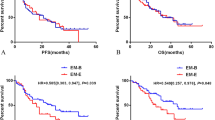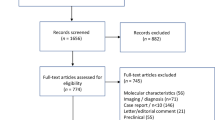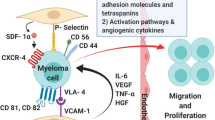Abstract
Extramedullary relapse (EMR) represents a poor prognostic marker in the course of multiple myeloma (MM). We reviewed data from 329 patients, diagnosed between 2000 and 2010, without extramedullary disease at onset to explore possible risk factors for EMR. The median overall survival of our study cohort was 6.4 years. The risk of EMR was 28 % with a median time from diagnosis to first EMR of 2.2 years (0.2–9.1 years). Patients with soft tissue masses located in extra-osseous organs (EMR-S) showed the worst outcome, compared to those with tumor masses arising from adjacent bone (EMR-B) (median OS 1.6 vs 2.4 years, p = 0.006). In addition, patients with EMR-S showed a significant trend for further development of extramedullary masses in a very short time (3.7 vs 5.7 months for EMR-B, p = 0.043). Multivariate analysis failed to identify any clinically presenting features predictive for EMR. The occurrence of EMR was higher in patients with more complex treatment history, defined on the basis of longer treatment duration (≥6 vs <6 months) and on elevated number of treatment lines administered (>2 vs ≤2 lines) (HR = 4.5, p < 0.001 and HR = 9.0, p < 0.001, respectively, when one or both factors are present).In conclusion, increasing burden of treatment might be a possible risk factor for EMR. MM patients with multiple relapses should be comprehensively investigated including, when possible, a whole-body-targeted radiologic technique to accurately detect EMR. Treatment choice should take into account the very poor outcome for patients with soft tissue involvement.

Similar content being viewed by others
References
Barlogie B, Tricot G, Anaissie E, Shaughnessy J, Rasmussen E, van Rhee F et al (2006) Thalidomide and hematopoietic-cell transplantation for multiple myeloma. N Engl J Med 354:1021–1030
Facon T, Mary JY, Hulin C, Benboubker L, Attal M, Pegourie B et al (2007) Melphalan and prednisone plus thalidomide versus melphalan and prednisone alone or reduced-intensity autologous stem cell transplantation in elderly patients with multiple myeloma (IFM 99-06): a randomised trial. Lancet 370:1209–1218
San Miguel JF, Schlag R, Khuageva NK, Dimopoulos MA, Shpilberg O, Kropff M et al (2008) Bortezomib plus melphalan and prednisone for initial treatment of multiple myeloma. N Engl J Med 359:906–917
Harousseau JL, Attal M, Avet-Loiseau H, Marit G, Caillot D, Mohty M et al (2010) Bortezomib plus dexamethasone is superior to vincristine plus doxorubicin plus dexamethasone as induction treatment prior to autologous stem-cell transplantation in newly diagnosed multiple myeloma: results of the IFM 2005-01 phase III trial. J Clin Oncol 28:4621–4629
Rajkumar SV, Jacobus S, Callander NS, Fonseca R, Vesole DH, Williams ME et al (2010) Lenalidomide plus high-dose dexamethasone versus lenalidomide plus low-dose dexamethasone as initial therapy for newly diagnosed multiple myeloma: an open-label randomised controlled trial. Lancet Oncol 11:29–37
Kumar S, Rajkumar SV, Dispenzieri A, Lacy MQ, Hayman SR, Buadi FK et al (2008) Improved survival in multiple myeloma and the impact of novel therapies. Blood 111:2516–2520
Martinez-Lopez J, Bladè J, Mateos MV, Grande C, Alegre A, Garcia-Larana J et al (2011) Long-term prognostic significance of response in multiple myeloma after stem cell transplantation. Blood 118:529–534
Bladé J, Fernández de Larrea C, Rosiñol L, Cibeira MT, Jiménez R, Powles R et al (2011) Soft-tissue plasmacytomas in multiple myeloma: incidence, mechanisms of extramedullary spread, and treatment approach. J Clin Oncol 29:3805–3812
Varettoni M, Corso A, Pica G, Mangiacavalli S, Pascutto C, Lazzarino M (2010) Incidence, presenting features and outcome of extramedullary disease in multiple myeloma: a longitudinal study on 1003 consecutive patients. Ann Oncol 21:325–330
Weinstock M, Ghobrial I (2013) Extramedullary multiple myeloma. Leuk Lymphoma 54:1135–1141
Wirk B, Wingard JR, Moreb JS (2013) Extramedullary disease in plasma cell myeloma: the iceberg phenomenon. Bone Marrow Transplant 48:10–18
Moreau P, Polliack A (2013) Extramedullary multiple myeloma: extra-osseous relapse is extra “bad news”, but why? Leuk Lymphoma 54:1349–1350
Papanikolaou X, Repousis P, Tzenou T, Maltezas D, Kotsopoulou M, Megalakaki K et al (2013) Incidence, clinical features, laboratory findings and outcome of patients with multiple myeloma presenting with extramedullary relapse. Leuk Lymphoma 54:1459–1464
Usmani SZ, Heuck C, Mitchell A, Szymonifka J, Nair B, Hoering A et al (2012) Extramedullary disease portends poor prognosis in multiple myeloma and is over-represented in high-risk disease even in the era of novel agents. Haematologica 97:1761–1767
Short KD, Rajkumar SV, Larson D, Buadi F, Hayman S, Dispenzieri A et al (2011) Incidence of extramedullary disease in patients with multiple myeloma in the era of novel therapy, and the activity of pomalidomide on extramedullary myeloma. Leukemia 25:906–908
Pour L, Sevcikova S, Greslikova H, Kupska R, Majkova P, Zahradova L et al (2014) Soft-tissue extramedullary multiple myeloma prognosis is significantly worse in comparison to bone-related extramedullary relapse. Haematologica 99:360–417
Fernandez de Larrea C, Jimenez R, Rosinol L, Gine’ L, Tovar N, Cibeira MT et al (2014) Pattern of relapse and progression after autologous SCT as upfront treatment for multiple myeloma. Bone Marrow Transplant 49(Jimenez R):223–227
Weinstock M, Aljawai Y, Morgan E et al (2015) Incidence and clinical features of extramedullary multiple myeloma in patients who underwent stem cell transplantation. Br J Haematol 169:851–858
Varga C, Wanling X, Laubach J, Ghobrial IM, O’Donnel EK, Weinstock M et al (2015) Development of extramedullary myeloma in the era of novel agent: no evidence of increased risk with lenalidomide-bortezomib combination. Br J Haematol 169:843–850
Blade J, Fernadez de Larrea C, Rosinol L (2015) Extramedullary disease in multiple myeloma in the era of novel agents. Br J Haematol 169:763–765
Katodritou E, Terpos E, Kastritis E, Delimpasis S, Symeonidis AS, Repousis P et al (2015) Lack of survival improvement with novel anti-myeloma agents for patients with multiple myeloma and central nervous system involvement: the Greek Myeloma Study Group experience. Ann Hematol 94:2033–2042
Touzeau C, Moreau P (2016) How I treat extramedullary myeloma. Blood 127(8):971–976
Usmani SZ, Mitchell A, Waheed S, Crowley J, Hoering A, Petty N et al (2013) Prognostic implications of serial 18-fluoro-deoxyglucose emission tomography in multiple myeloma treated with total therapy 3. Blood 121:1819–1823
Zamagni E, Cavo M (2012) The role of imaging techniques in the management of multiple myeloma. Br J Haematol 159:499–513
Ludwig H, Miguel JS, Dimopoulos MA, Palumbo A, Garcia Sanz R, Powles R et al (2014) International Myeloma Working Group recommendation for global myeloma care. Leukemia 28:981–992
Mesgnich C, Fardanesh R, Tenembaum L, Chari A, Jagannath S, Kostakoglu L (2014) State of the art imaging in multiple myeloma: comparative review of FDG-PET/CT imaging in various clinical settings. Eur J Rad 63:2203–2223
Tirumani SH, Sakellis C, Jacene H, Shinagare AB, Munshi NC, Ramaiya NH et al (2016) Role of FDG-PET/CT in extramedullary multiple myeloma: correlation of FDG-PET/CT findings with clinical outcome. Clin Nucl Med 41:e7–e13
Zamagni E, Nanni C, Mancuso K, Tacchetti P, Pezzi A, Pantani L et al (2015) PET/CT improves the definition of complete response and allows to detect otherwise unidentifiable skeletal progression in multiple myeloma. Clin Cancer Res 21(19):4384–4390
Fernández de Larrea C, Kyle RA, Durie BG, Ludwig H, Usmani S, Vesole DH et al (2013) Plasma cell leukemia: consensus statement on diagnostic requirements, response criteria and treatment recommendations by the International Myeloma Working Group. Leukemia 27:780–791
Pérez-Simón JA, Sureda A, Fernández-Aviles F, Sampol A, Cabrera JR, Caballero D et al (2006) Reduced-intensity conditioning allogeneic transplantation is associated with a high incidence of extramedullary relapses in multiple myeloma patients. Leukemia 20:542–545
Qu X, Chen L, Qiu H, Lu H, Wu H, Qiu H et al (2015) Extramedullary manifestation in multiple myeloma bears high incidence of poor cytogenetic aberration and novel agents resistance. Biomed Res Int 2015:787809, Epub 2015 Apr 23
Greaves M, Maley CC (2012) Clonal evolution in cancer. Nature 481:306–313
Morgan GJ, Walker BA, Davies FE (2012) The genetic architecture of multiple myeloma. Nat Rev Cancer 12:335–348
Keats JJ, Chesi M, Egan JB, Garbitt VM, Palmer SE, Braggio E et al (2012) Clonal competition with alternating dominance in multiple myeloma. Blood 120:1067–1076
Egan JB, Shi CX, Tembe W, Christoforides A, KJurdoglu A, Sinari S et al (2012) Whole-genome sequencing of multiple myeloma from diagnosis to plasma cell leukemia reveals genomic initiating events, evolution, and clonal tides. Blood 120:1060–1066
Magrangeas F, Avet-Loiseau H, Gouraud W, Lode’ L, Decaux O, Godmer P et al (2013) Minor clone provides a reservoir for relapse in multiple myeloma. Leukemia 27:473–481
Bolli N, Avet-Loiseau H, Wedge DC, Van Lool P, Alexandrov LB, Martincorena I et al (2014) Heterogeneity of genomic evolution and mutational profiles in multiple myeloma. Nat Commun 5:2997
Brioli A, Melchor L, Cavo M, Morgan GJ (2014) The impact of intra-clonal heterogeneity on the treatment of multiple myeloma. Br J Haematol 165:441–454
Sevcikova S, Paszekova H, Besse L, Sedlarikova L, Kubaczkova V, Almasi M et al (2015) Extramedullary relapse of multiple myeloma defined as the highest risk group based on deregulated gene expression data. Biomed Pap Med Fac Univ Palacky Olomouc Czech Repub 159:88–93
Acknowledgments
SM, AP, FC, MV, CC, MC, and AC performed the research. SM, AC, MC, VF, and CK designed the study participated in the statistical analysis and wrote the paper.
Author information
Authors and Affiliations
Corresponding author
Ethics declarations
Conflict of interest
The authors declare that they have no conflict of interest.
Rights and permissions
About this article
Cite this article
Mangiacavalli, S., Pompa, A., Ferretti, V. et al. The possible role of burden of therapy on the risk of myeloma extramedullary spread. Ann Hematol 96, 73–80 (2017). https://doi.org/10.1007/s00277-016-2847-z
Received:
Accepted:
Published:
Issue Date:
DOI: https://doi.org/10.1007/s00277-016-2847-z




